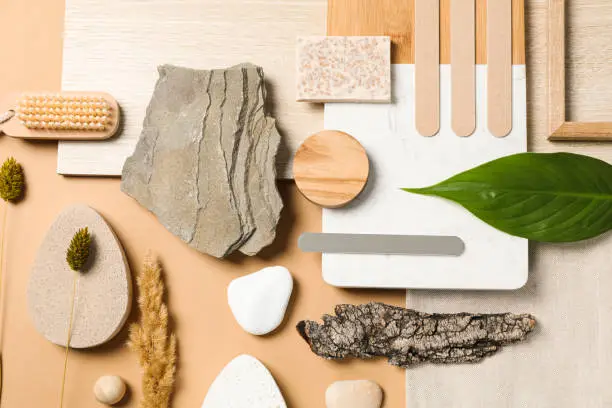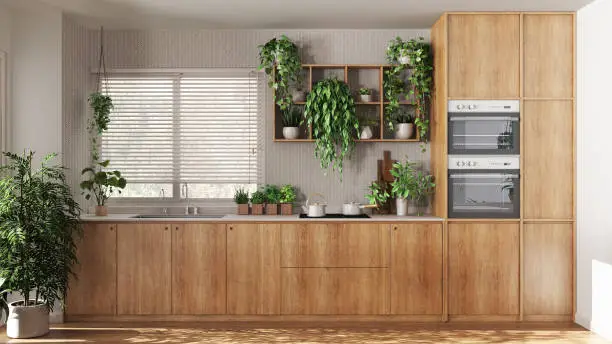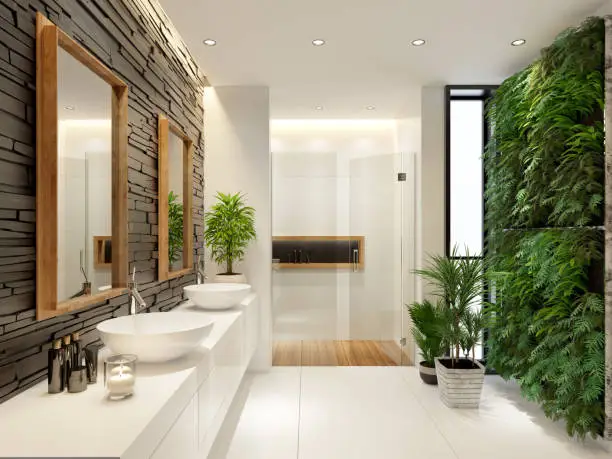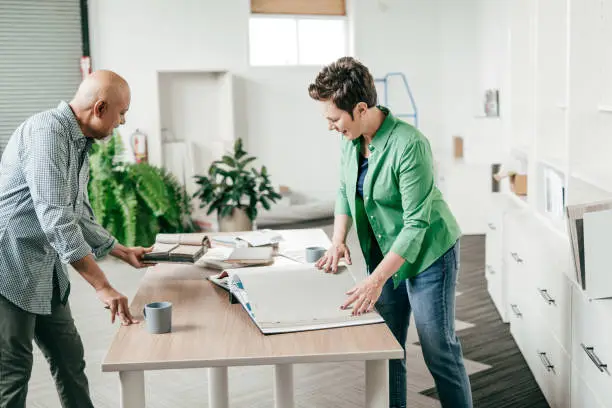Biophilic design combines nature and the built environment, transforming kitchens and bathroom remodels into polished, health-focused designs. The below advice describes how to utilize natural light, diverse textures, and sustainable materials to design contemporary interiors to promote the sense of connection with nature and improve personal well-being.
What Is Biophilic Design and Why It Matters in Remodeling

Biophilic design is not a fad, it is an intentional attempt to reintegrate the built indoor space with nature. This paradigm is founded on the principle that human beings can live best when they are in close contact with nature; hence, it lays stress on organic materials, earthy coloring schemes, plants, and natural light. Biophilic elements have taken center stage in the contemporary interior design and more so in the kitchen and bathroom remodeling because sensory involvement in these spaces is unavoidable.
Besides its aesthetic purpose, biophilic design contributes greatly to cognitive clarity, emotional stability, and physical wellbeing in general. Using it in rehabilitation works makes a place more comfortable and habitable and simultaneously drives sustainable and environmentally conscious architecture. The principles of the biophilic design thought can be implemented easily in high-traffic areas, like kitchens and bathrooms, to create the environments that can reduce stress and enhance everyday activities.
Connecting With Nature Through Interior Spaces
Though kitchens and bathrooms are often thought of as functional spaces, biophilic design adds an element of comfort and relaxation to these essential areas. Large windows, natural shapes, and rough surfaces create an interior simulation of nature. Such solutions as open shelving, which includes ceramic or stone elements, may imply natural landscapes, whereas daylight, which is accessible through those windows, creates a flow of a constantly changing visual environment.
Benefits of Biophilic Elements for Mental Health and Wellbeing
Scientific studies show that natural elements can reduce the level of cortisol, improve concentration, and speed up the healing process. Plants and natural light also contribute to a better mood and reduced fatigue in a domestic setting. Biophilic design improvements like cozy wooden surfaces, plants, and exterior views can be found in kitchens and bathrooms, creating a peaceful environment, which is especially important to active families.
Biophilic Kitchen Remodeling Ideas

A kitchen renovation is a perfect opportunity to use the principles of biophilia. Whether the project involves building up or redesigning an outmoded setup, incorporating natural finishing, organic forms, and cues that help the occupant orient to the exterior will fundamentally re-center the area.
Natural Materials Like Wood and Stone
The deliberate use of natural materials, especially reclaimed wood, marble countertops, and unglazed terracotta tiles, will give a kitchen instant warmth and authenticity. These materials obtain patina with the passage of time, thus adding a unique character to the room. Also, they have a touchy nature that reminds of the textures of the natural world, an ability that is hardly ever achieved by synthetic substitutes.
Comparison Table: Natural vs. Synthetic Materials in Kitchen Remodeling
| Feature | Natural Materials (e.g., wood, stone) | Synthetic Materials (e.g., laminate, vinyl) |
|---|---|---|
| Durability | High (with proper care) | Medium |
| Eco-Friendliness | High (sustainable and recyclable) | Low to Medium |
| Tactile and Visual Appeal | Rich, varied textures | Uniform, less natural |
| Cost | Generally higher upfront | More budget-friendly |
Indoor Plants and Herb Gardens Within Kitchen Spaces
Well-placed plants can essentially change the atmosphere of a kitchen. Planters hung on the wall or planters with herbs placed on a windowsill or even vertical gardens along a backsplash each add greenery without losing valuable counter space. These installations are mutually beneficial in two ways; the ease of access to fresh herbs to spice up culinary preparations and the bonus of improved indoor air quality.
Benefits of Indoor Herb Gardens:
-
Enhances cooking experience with fresh ingredients
-
Purifies air and adds moisture
-
Introduces pleasant natural scents to your kitchen
Bringing Nature into Bathroom Renovations

Bathrooms are often cold or sterile; however, biophilic design remodeling can add warmth and calmness to it. This effect is further supported by the introduction of natural lighting, moisture-friendly vegetation and organic textures, which are usually found outside in the spa environment.
Natural Light Maximization and Skylights
Putting large windows or skylights into the bathroom will make a person more exposed to daylight, which will aid in managing circadian rhythms and uplifting the overall mood. Light filtering blinds or frosted glass lets the sunlight enter the room, but the room is isolated. In addition, it is possible to strengthen the effect of natural light with the help of mirrors and reflective tiles in the whole territory.
Green Walls and Sustainable Fixtures
Bathrooms can be equipped with vertical gardens, also known as green walls, using moisture-tolerant plants like ferns, bamboo, or spider plants. The environmental-friendly design is supported by sustainable fixtures such as low-flow faucets and vanities made of compostable materials.
Design Tips for Biophilic Bathrooms:
-
Opt for ceramic tiles with natural, uneven finishes
-
Choose calming colors like sage green, soft beige, or sky blue
-
Use bamboo or reclaimed wood for shelving and cabinetry
Choosing Contractors Skilled in Biophilic Design

Biophilic design remodeling requires a high degree of care and an instinctive understanding of occupant interaction with built environments. The key to achieving the aesthetic intentions of the endeavor and satisfying its functional needs lies in the partnership with a suitable remodeling contractor.
Finding Experts with Experience in Eco-Friendly and Nature-Inspired Projects
In your search of contractors, ask them about their exposure to use sustainable building material as well as their knowledge of designs based on nature-centric philosophy. Choose companies capable of providing references or portfolios with biophilic kitchens and bathrooms. Credential: LEED certification or membership in green-building organizations are good measures of such expertise.
Planning Layouts That Maximize Connection to Outdoors
A properly planned interior design is a must to cope with the indoor spaces in a manner which blends them with the exterior environment. Contractors are able to locate preparing spaces, sinks, and mirrors in line with windows, position potential views of gardens, or increase the continuity of space by incorporating sliding doors. These decisions require a careful consideration of natural light paths, privacy, and building limitations.
Maintenance Tips for Biophilic Kitchen and Bathroom Features

Nature inspired design is usually advantaged by strategic maintenance patterns that maintain appearance and functionality of the design. With a careful maintenance, these solutions can last many decades and keep on providing practical benefits to the household.
Caring for Indoor Plants and Natural Materials
Name plants that are hardy and require little maintenance, and use moisture-retentive soil and trustworthy drainage. In case of choosing natural material as flooring or decor, use minerals, metals, or slate, and clean them with plant-based products to prevent damage to the surface. Maintenance like sealing or oiling keeps the wood and stone looking good and so prolongs its usefulness.
Balancing Practicality and Aesthetic Appeal
Biophilic design should foster the feeling of calmness without decreasing functionality. Reduce clutter by using storage options that can merge with the natural finish of the surroundings. Mood lighting and task lighting should be easily repositioned, and the fixtures adopted should meet the practical needs of the household.
Frequently Asked Questions (FAQs)
1. What are easy ways to add biophilic design to my remodel?
Simple improvements can also be done: the addition of indoor vegetation, the use of natural lighting sources e.g. skylights or large windows, and the use of natural materials e.g. wood, stone. A grounded colour scheme and open plan arrangement also supports biophilic concepts. The homeowners can also think of a living herb garden integrated into the kitchen or put up shelves that promote vegetation in the bathroom. Paintings that are based on natural motives can also give visual peace. Finally, the best solution is deliberate design where human well-being is prioritized.
2. How does biophilic design affect home value?
Biophilic design has become quite popular in modern residential construction, with homeowners valuing wellness, sustainability, and aesthetic design. It achieves a long-lasting practicality and aesthetic appeal by using long-lasting natural materials and designs that maximize daylight. Real-estates that are equipped with wellness facilities tend to have a higher resale value, especially in competitive housing markets. Besides, these environments are photographed better, which leads to even more online attention. Therefore, biophilic design is simultaneously an investment in human health and a marketability of a residential property.
3. Can I add plants to small kitchens and bathrooms?
Yes, indeed. Vertical gardens or hanging planters or wall-mounted pots are made specifically to fit small areas. Choose plants that grow well in low light and high humidity like pothos, ferns, or peace lilies. You can also look at inbuilt planters along walls or on top of cabinets to save on space. A tiny corner shelf with succulents or herbs can have a significant effect. Plants also help in relieving stress and cleaning air.
4. Are natural materials more expensive for remodeling?
The use of natural materials like marble, quartzite and hardwood is more costly to install but tend to last longer than their synthetic alternatives. Their natural beauty adds a long-term fascination and allows less frequent replacement. Green decisions bamboo or reclaimed wood are an intermediate option: environmentally friendly and relatively cost effective. Finally, spending on natural materials may pay off in the form of better durability and resale value and at the same time improve indoor air quality.
5. Does biophilic design improve indoor air quality?
Indeed, biophilic remodeling significantly enhances indoor air quality when done with caution. Plants act as natural air filters and sustainable materials, including low-VOC paints and finishes, reduce the toxic off-gassing. Improved ventilation systems, particularly in kitchens and bathrooms, also guarantee the flow of fresh clean air. Moisture accumulation is minimized with natural lighting and airflow, and thus the risk of mold development is decreased. All these measures make the environment more breathable and healthier.
In case you want to bring the healing effects of the natural world into your living space by means of a wellness-based remodeling, KBR Kitchen and Bath is prepared to help. Are you redesigning a kitchen to include natural wood cabinetry or a bathroom into a spa-like garden? No matter what your project entails, we provide biophilic kitchen design and bathroom remodeling services to improve health, beauty, and functionality. To ensure the best value of your project, book a free consultation with one of our remodeling experts by visiting one of our showrooms in Fairfax, Bethesda (Kitchen), Bethesda (Bathroom), or Manassas, or by calling us.

